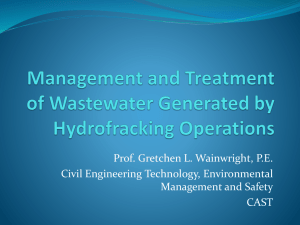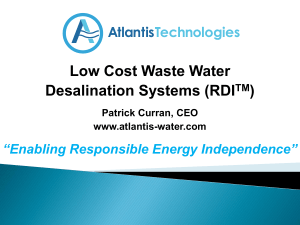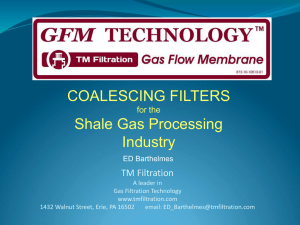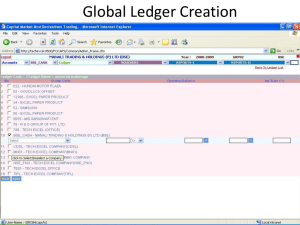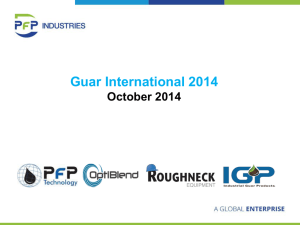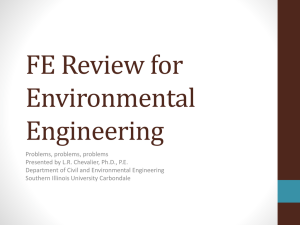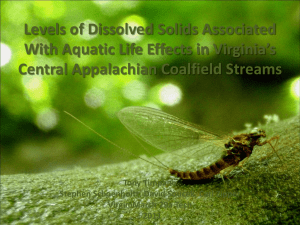Bioassay Laboratory QA/QC Expectations
advertisement
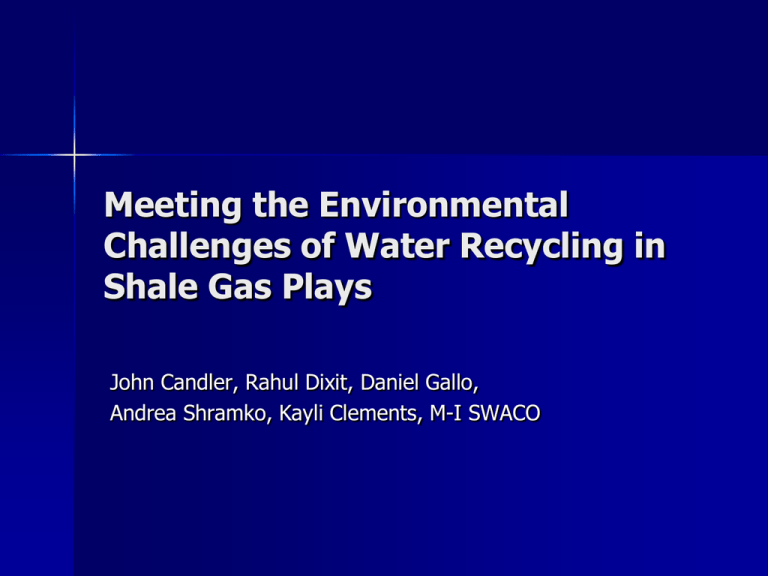
Meeting the Environmental Challenges of Water Recycling in Shale Gas Plays John Candler, Rahul Dixit, Daniel Gallo, Andrea Shramko, Kayli Clements, M-I SWACO Water challenges in shale plays • Water supply - Groundwater - Water Discharge Treatment and reuse is a solution to water challenges Water Returned For Reuse Processing Technologies: • • • • • • Closed loop system 100% recycle Clean Water Returned To Hydrologic Cycle Chemical Mechanical Thermal Filtration Membranes Electro coagulation Challenges for recycling and reuse Business Technical Regulatory Business Issues Two Recycle Approach Options Flowback Water Treated water Offsite/Local Treatment Facility Onsite treatment CONFIDENTIAL INFORMATION ©2009 M-I L.L.C. Mobile and Central Treatment Facilities Mobile Treatment for single wells 5,000 to 10,000 bbl per day Quick rig up and rig down Trailer mounted for transportation Small footprint • Filtration Unit: 35 ft x 10 ft • Reclamation Unit: 120 ft x 120 ft Central Treatment Facilities 60,000 to 100,000 bbl per day Central Facilities for Multiple wells in the area Strategically located In-line with drilling program requirements Treatment and re-use of 100% of produced waters Minimum operating volumes required to justify the investment Service based approach offers comprehensive services from characterization to treatability. Traditional Water treatment solutions Oilfield Service based approach Shale Gas Reservoirs: The Need for Frac Flowback Treatment Each well is initially fractured in 8 to 12 stages Average 10,000 bbl of water are used per stage 130 bbl/truck – 77 trucks per stage 18-30% of the water flows back H2O2 Fe 2+ 9 Water Recycling Treatment Technologies – Summary Provide environmental control and limiting future environmental liability Use best available technology and practices Quality control of water and waste Minimize use of valuable natural water sources Consistent HSE management and controls State Summary State Shale Play Major Issue Marcellus Disposal Louisiana Haynesville Recycling/Sourcing Texas Haynesville Sourcing Pennsylvania Sourcing • Regulated by seasonal availability Water needs varies from region to region based on factors from regulations to transport cost SOURCE: M-I SWACO; EIA; Deutsche Bank; shalegas.com; USGS; NPC; McKinsey analysis Disposal/Recycle Technology Flowback Water Management Flowback Storage in Tanks or Lined Pits Almost always trucked Less frequently (but increasing) operators may recycle … Treat and recycle, or…just dilute with makeup water and reuse for next job Regions without disposal wells may use commercial treatment works, which then dispose to waterways Typically injected in Class II Brine Injection well some distance away ~ 10 minutes to 6 hours Issues with recycle and beneficial reuse: • Is the secondary material similar to an analogous raw material or product? • What degree of processing is required to produce a finished product? •What is the value of the secondary material? •Is there a guaranteed market for the end product? • Is the secondary material handled in a manner consistent with the raw material/product it replaces? Specifications for Frac water • • • No regulatory specifications set for frac water quality Currently no regulations for fracking process (except casing) EPA currently evaluating whether hydraulic fracturing should be regulated as underground injection wells and under the same jurisdiction Fracturing Fluid Makeup Why do we need to treat the flowback for reuse? Concerns Culprits Potential Impacts Scaling Hardness, Metals Plugging Formation, Increase equipment cost Corrosion Hardness, Bacteria Plugging Formation, Increase equipment cost NORM Barium, Strontium QHSE Gel Stability Divalent cations Too high divalent cations can cause conflict with gel stability to support proppant conduction H2S Sulfate Reducing Bacteria Strong environmental and safety concerns Water Treatment Specifications Haynesville Shale Area: TSS pH (mg/L) Operator #1 TDS (mg/L) Calcium (mg/L) Barium (mg/L) Iron (mg/L) Bacteria (CFU/ml) 7-8 < 10 Operator 2: 7-9 <10 < 65,000 3,000 1,200 <25 No spec <20,000 <300 <100 <10 100 Marcellus Shale Area: TSS pH (mg/L) Operator #1 TDS (mg/L) Calcium (mg/L) Barium (mg/L) Iron (mg/L) Bacteria (CFU/ml) 7-8 < 10 Operator 2: < 100,000 <3,000 <100 <25 No spec <10 <20,000 <300 <100 <10 100 <10 No spec No Spec <10 <10 No spec 7-9 Operator 3: 7-9 TREATMENT TECHNOLOGIES Water Management Solutions Blending Blending Treatment Operation Water Management Solutions Filtration Filtration System Targets removal of TSS, using filter cartridges/socks. Filtration System Example Operational Highlights (Filtration System Central Site) Processed over 1M bbls of flowback water Treats and processes average of 5,000 bbl/12 hours 99.9% water recovery 1,000 bbls of waste sent to disposal Contaminates removed from flowback water (ppm): Water Management Solutions Reclamation Reclamation System Flowback Water Reclamation System Trial Results: Calcium Removal: 9,400 ppm to 34 ppm Magnesium Removal: 570 ppm to 6 ppm TDS reduction 61,100 ppm to 39,100 Reclamation System Example Operational Highlights (Reclamation System Mobile Unit) Typical Flowback Water Processed per Well 10,500 bbls Treats and processes 3,000 bbl /12 hours 97% water recovery 125 bbls of waste sent to disposal Contaminates removed from flowback water (ppm): Water Management Solutions RO Pretreatment - Membrane Technology pH adjustment Flow Back Water Oil Removal Oil Clarification Sludge Ion Exchange Ultra Filtration Antiscalant & pH Adjustment • Hardness • Iron Reverse Osmosis Reverse Osmosis - RO Features: Remove TDS and can handle up to 40K TDS. Pre-treatment includes: TSS, oil, and some hardness removal 35 - 40% recovery drinking water quality Inexpensive with less than 40K TDS flow back & produced waters Low energy input required Water Management Solutions Thermal Pretreatment - Thermal Technology Antiscalant • Defoamer • Corrosion Inhibitor • pH adjustment Flow Back Water Clarification/ Filtration Suspended Solids Thermal Technology Mechanical Vapor Recompression Flow (m3/day) Na Mg Ca Sr Ba Fe Cl HCO3 SO4 TDS Feed Concentrate 2450 450 13750 74861 161 877 1480 8058 292 1590 16.4 89 28.4 155 23900 130122 536 0 79.7 434 40243.5 216185 Distillate 2000 6 1.75 2.45 0.8 0.159 0.23 18.4 0 0 29.789 Regulatory challenges Disposal/Recycle •RCRA rules apply for all waste •States have jurisdiction for treatment and disposal •Produced/Flowback waters cannot be directly discharged General Commonalities Well Activities • No specifications set for frac water quality • Currently no regulations for fracking process (except casing) • EPA currently evaluating whether hydraulic fracturing should be regulated as underground injection wells and under the same jurisdiction Initial Design of EPA Research. Study on Potential Relationships Between Hydraulic Fracturing and Drinking Water Resources. U.S. Environmental Protection Agency Office of Research and Development. March 2010. http://yosemite.epa.gov/sab/sabproduct.nsf/0/3B745430D624ED3B852576D400514B76/$File/Hydraulic%20Frac%20Sco ping%20Doc%20for%20SAB-3-22-10%20Final.pdf Laboratory Requirements Waste Characterization Water Analysis Treatment Evaluations Regulatory Compliance Water Characterization Requirements Analytical laboratory offers state-of-the art instrumentation for data validation and methods development purposes Field Kits available to all operations Analytical Laboratory Analyte Field Kit AA or ICP-MS Al, Ba, Ca, Fe, Mg, Mn, Si, Sr, SO4, X IC Sulfate X Gravimetry TDS X Titration Alkalinity, Cl X Gravimetry TSS NTU (Clarity) X AA: Atomic Absorption ICP-MS: Inductively Coupled Plasma Mass Spectroscopy IC: Ion Chromatography NTU: Nephelometric Turbidity Units Water Analysis and Bench Treatment Evaluation Personnel & Equipment • Water analysis before and after •Bench scale Treatment Before Treatment After Treatment Regulatory Compliance Testing Identification of test parameters Development of test protocols for field testing and offsite lab testing Sampling procedures and frequency Documentation and reporting procedures THE PATH FORWARD Life Cycle Analysis Air Discharges Water Discharges Solid Waste Biodiversity protection Resource consumption Use of Good Science Transparent Operations Dedication to waste minimization approach The Big Picture Operators Service Companies Regulators Other Stakeholders – – – – – Public Participation Research Organizations NGOs Industry trade groups Technology providers Positive Change Remain engaged with local authorities Conserve resources • Practice Responsible Withdrawal • Implement Recycling • Identify other industrial water sources Be proactive in the community Protect groundwater/ surface water resources
